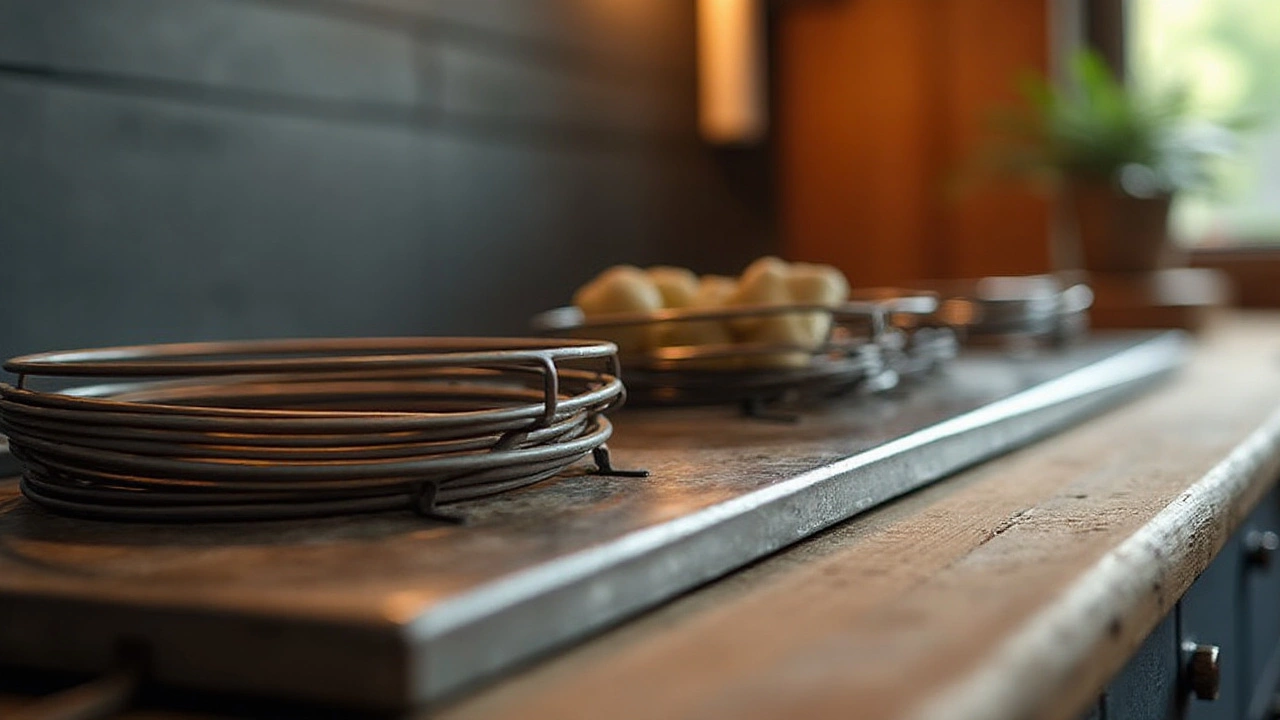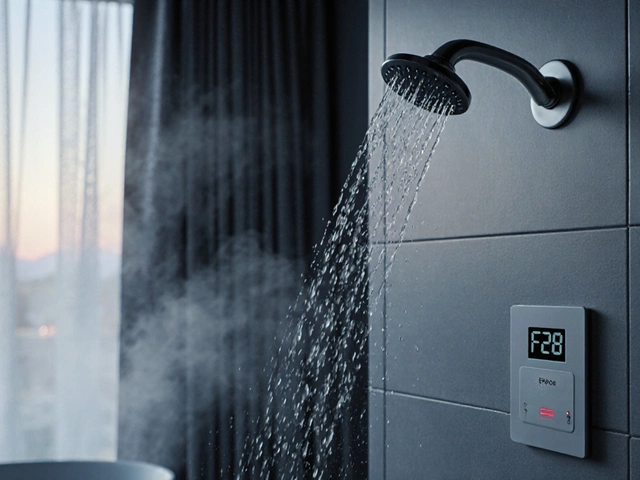When your electric oven stops heating evenly or doesn't heat up at all, a faulty element might be the culprit. Replacing this component can seem daunting, but understanding the costs and the replacement process can make it much less intimidating. Whether you're a DIY enthusiast or prefer the assurance of a professional touch, knowing what influences the price of this task is essential for making informed decisions.
In this article, we'll explore the various factors that have a say in the cost of replacing an oven element. From different element types to the pros and cons of handling the fix yourself, we've got you covered. We'll also discuss the tools you'll need and throw in some handy longevity tips for your oven components. So let's ensure your meals are cooked to perfection once again!
- Factors Affecting Replacement Costs
- Types of Oven Elements
- DIY vs. Professional Replacement
- Tools Required for Replacement
- Tips for Prolonging Oven Element Life
Factors Affecting Replacement Costs
Replacing the heating element in an electric oven can significantly vary in price, depending on a few critical variables. These variables can impact not only the upfront cost of the replacement part but also any additional fees you might incur, such as labor costs if you choose professional installation. One of the most substantial factors is the type of element your oven uses. Generally, ovens come with a baking element at the bottom and a broiling element at the top. The model and make of the oven dictate which specific element you'll need, and this can significantly influence the price because some proprietary brand parts can be pricier than generic options.
Another crucial factor is whether you decide to pursue a DIY approach or hire a professional. Professional services come with the advantage of expertise and can ensure the job is done correctly without causing additional damage to surrounding components. Yet, this convenience comes at a cost, which varies based on your location and the technician's experience. According to HomeAdvisor, professional installation could cost anywhere from $100 to $200, whereas a DIY project might only set you back the price of the element itself.
Geographic location plays a role beyond professional fees. Availability of parts can fluctuate based on where you live, especially if you're in a rural area or somewhere with limited access to hardware stores or shipping services. This can lead to a longer wait time for parts to be shipped, potentially escalating costs if you need expedited delivery.
“The cost of home appliance repair often depends on both the complexity of the job and the accessibility of parts in the region.” — Consumer ReportsAdditionally, the age and model of your oven are worth noting. Older or discontinued models may have parts that are harder to find, making them potentially more expensive. In contrast, newer models might offer more generic parts that can be easily purchased online or in-store.
Occasionally, the cost may also be influenced by the season or specific point in time. During holiday seasons or high-demand periods like Thanksgiving, parts can become scarce or slightly more expensive due to increased demand, as everyone rushes to have a functioning oven for their holiday meals.
Several minor factors can play a role in the pricing. These involve shipping costs, whether you're opting for express delivery, and any potential taxes or fees added during purchase. Before purchasing a replacement element, it's a good practice to conduct a thorough cost analysis, examining all potential expenses related to this small yet critical mission to restore your oven.
Types of Oven Elements
Electric ovens rely heavily on their elements to function effectively, and understanding the types of oven elements is key to maintaining your appliance's health. These elements are the heating bones of your oven, tasked with generating the warmth needed to bake, roast, and broil. Generally, they fall into three main categories: bake elements, broil elements, and convection elements. Each of these plays a unique role that keeps our food perfectly cooked. The bake element tends to be positioned at the bottom of the oven cavity and is responsible for the steady and even heat perfect for baking. On the opposite end, the broil element sits atop, providing intense heat ideal for searing and grilling.
Delving deeper, it's fascinating to learn about how each element works. Let's start with the bake element, which might be the most used, given our penchant for delightful pastries and evenly-cooked stews. It's designed to maintain a consistent low to medium temperature, ensuring your recipes come out just right. Meanwhile, the broil element functions more like your oven's grilling accessory. Positioned on top, it is perfect for melting cheese or crisping fish skin with its direct heat that browns surfaces quickly and efficiently. This is why your broil element should never be overlooked; it could be the little secret behind your culinary finesse.
The rise of convection ovens added another layer to our understanding of oven elements. Convection elements come complete with a fan that circulates the heat, providing a more uniform cooking environment. It means better texture and flakier crusts, something every chef appreciates. As Marion Nestle once said in her acclaimed book, "The Art of Cooking":
"Understanding your appliances is the first step towards mastering the art of perfect meals."This layered understanding of different elements helps us address whether an element needs fixing or replacing.
An interesting aspect to consider is that not all ovens have all three element types. While many modern ovens come equipped with each, some older models may only have bake and broil elements. This variance can often affect the cost of oven element replacement, as legacy models may have pricier, hard-to-find parts. Thankfully, frequent manufacturers like GE or Whirlpool usually stock the components even for older units, albeit at a varied cost range. The decision to replace the elements comes down to how frequently the oven is used for specific tasks—whether it’s a baker’s delight or a home chef's daily necessity.
To summarize the types conveniently, we can look at their distinctions in a simple format:
| Type of Element | Position | Main Function |
|---|---|---|
| Bake Element | Bottom | Steady heating for baking |
| Broil Element | Top | High-intensity heat for grilling |
| Convection Element | Rear | Even heat distribution with a fan |
Savvy oven owners would do well to learn about these distinct roles, allowing them not only to execute repairs but also optimize their cooking. After all, knowledge is as vital in the kitchen as your secret family recipe.

DIY vs. Professional Replacement
When faced with the task of replacing an oven element, homeowners often wonder whether to take the DIY route or call in a professional. Each option has its benefits and drawbacks that go beyond just the cost involved. Replacing an oven element yourself can be more cost-effective because you eliminate labor fees and only need to purchase the necessary parts. However, it also requires you to feel comfortable working with electrical components, which can be potentially hazardous if done improperly.
Tackling this repair on your own means you need to research, often meticulously, the correct type of element required for your specific model among various types of oven elements. You might find yourself flipping through manuals or searching online databases provided by manufacturers. This process can feel quite empowering, giving you the knowledge to not just fix ones' appliances, but also an appreciation of how they work. If executed with precision, it can lead to a sense of pride and accomplishment.
On the professional side, hiring an experienced technician assures the job is done safely and efficiently. These experts bring with them the tools, skills, and experience to diagnose other potential problems. Technicians typically offer a warranty or guarantee on their work, providing peace of mind. According to the Appliance Servicers Association, being professional means your oven can be up and running much quicker than if you were to do it yourself. However, opting for professional help may significantly increase overall costs.
"A reputable technician can identify issues faster and ensure longevity of parts, which saves time," states Jim Hawkins, a veteran appliance repair specialist.
When deciding between DIY and hiring a professional, consider the time and confidence you have in handling electric components, which have their fair share of risks. The potential for harming the oven, creating safety issues, or voiding warranties can make the DIY approach perilous. Moreover, although a professional service might not be the cheapest option, it could very well prevent compounding repair costs if an error occurs during a DIY attempt.
For those interested in comparing costs, a notable study by the Consumer Electronics Repair Association reveals an interesting insight. They found, on average, that a professional oven element replacement costs between $150 and $300, depending on the repair company's rates and location. Doing it yourself? You'll probably spend significantly less, maybe only $20 to $30 for the part. However, keep in mind that these savings assume the replacement goes without a hitch.
In the end, choosing between doing it yourself or going pro with your electric oven repair is personal, hinging on one's skill, budget, and comfort. Weighing these factors carefully gives you the best shot at making a decision you'll feel good about. Remember to thoroughly assess not just the financial aspects, but also the safety implications associated with your choice.
Tools Required for Replacement
Undertaking the task of replacing an oven element requires not just courage, but also the right set of tools. While it may seem like a simple swap, having the correct tools on hand can make the process smooth and efficient. At the heart of any electric oven repair job is a trusty screwdriver set. Most electric ovens have screws that attach the element to the oven's interior, and these can vary in type. Phillips head and flathead screwdrivers are staples in this toolkit. In certain instances, a nut driver might also prove indispensable, especially when encountering stubborn screws that need a bit more persuasion to come loose.
Next, a multimeter is invaluable for safety and diagnostic purposes. By measuring resistance, it determines whether the element is indeed faulty or if a different component is to blame. Taking this precaution can save unnecessary replacement costs and efforts. "Safety should never be an afterthought," reminds industry veteran Mike Holmes.
"Always ensure the power supply is off before starting any electrical jobs,"which is why an outlet tester can complement your toolkit. This tool verifies that the oven's power is disconnected, ensuring a safer working environment.
A flashlight or a headlamp is highly recommended, given that ovens often have poorly lit interiors. This tool not only aids in visibility during removal and installation but also helps avoid mishandling and potential damage to delicate wiring inside the oven. Speaking of wiring, having a set of needle-nose pliers can be beneficial for maneuvering tight spaces and managing wires with precision. If cutting or stripping is required, a wire cutter/stripper will be necessary as well.
Lastly, don’t forget a simple cloth or paper towel to wipe away grease or grime gathered around the element area. Keeping things clean reduces the likelihood of residues affecting the new component's performance. Adding optional tools, such as a little bowl or tray for keeping small screws secure, can also keep your workspace organized. Bringing all these tools together under one roof ensures that the process of replacing an oven element is as hassle-free as possible.
In conclusion, assembling the right toolset significantly supports a successful and efficient repair venture. Without these essential tools, replacing an element can become a frustrating, if not impossible, endeavor. A detailed, careful preparation remains the key to a seamless and satisfying DIY experience. So equip yourself strategically, and soon enough, your oven will be back in action, ready to deliver the culinary delights you love.

Tips for Prolonging Oven Element Life
The heart of a kitchen’s culinary success often lies in the reliable performance of its appliances, and an electric oven is no exception. Keeping your oven element functioning optimally isn't just about addressing repairs when they arise; it's about taking proactive measures to extend the life of an essential kitchen component. By following a few simple practices, not only will you keep your oven in top shape, but you'll also save on potentially costly electric oven repair expenses.
One of the most effective ways to protect your oven element is to regularly clean your oven. Cooking splatters and residue can accumulate over time, leading to burned spots that put strain on the element. Using a soft cloth and a gentle, non-abrasive cleaner can help you wipe away grime without inflicting damage. But remember, it's not just about routine cleaning; avoiding the urge to use your oven as a storage space is crucial. Heavy pots and pans stored inside when the oven is on can interfere with heat distribution, inadvertently shortening the life of the oven element.
Temperature control is another key factor in preserving your oven's longevity. Consistently baking or roasting at extremely high temperatures can accelerate wear and tear. When possible, moderate heat levels should be your go-to. Also, it's worth paying attention to preheating and over-baking. Giving your oven more time than necessary to preheat can overextend the oven element, and over-baking not only risks your food but can push your element to its limits as well. It’s wise to rely on a good-quality oven thermometer to help maintain accurate cooking temperatures, minimizing unnecessary stress on the appliance.
Besides habitual care, consider integrating regular inspections as part of your appliance maintenance routine. Check on the element for signs of blistering or cracks, as those are indicators that a replacement might be due soon. During these checks, ensure that the oven’s wiring and insulation remain intact, as these influence the overall efficiency of the oven and, consequently, the health of the oven element. If you’re ever uncertain about the state of your oven, consulting a professional can provide clear insights and peace of mind.
Engaging in these practices doesn't just extend the life of your oven element; it bolsters your own culinary confidence. As a quote from a well-celebrated home economist said, "The secret to a long-lasting oven is a patient chef who respects it like a good friend." By investing the little extra time and attention now, you’ll reap the delicious rewards later.





